Top Rankings
Happy Valley Union Elementary School District ranks among the top 20% of public school district in California for:
Category
Attribute
Diversity
Most diverse schools (Top 1%)
For the 2025 school year, there are 3 public schools serving 484 students in Happy Valley Union Elementary School District. This district's average testing ranking is 5/10, which is in the bottom 50% of public schools in California.
Public Schools in Happy Valley Union Elementary School District have an average math proficiency score of 28% (versus the California public school average of 33%), and reading proficiency score of 34% (versus the 47% statewide average).
Minority enrollment is 46% of the student body (majority Hispanic), which is less than the California public school average of 80% (majority Hispanic).
Overview
This School District
This State (CA)
# Schools
3 Schools
10,369 Schools
# Students
484 Students
5,826,838 Students
# Teachers
24 Teachers
268,012 Teachers
Student : Teacher Ratio
20:1
20:1
District Rank
Happy Valley Union Elementary School District, which is ranked #1137 of all 1,925 school districts in California (based off of combined math and reading proficiency testing data) for the 2021-2022 school year.
Overall District Rank
#1241 out of 1941 school districts
(Bottom 50%)
(Bottom 50%)
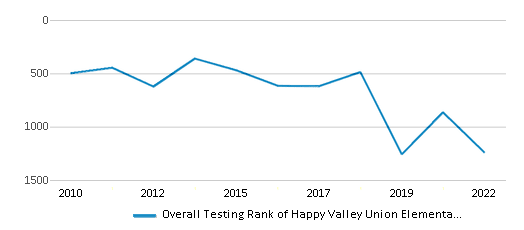
Math Test Scores (% Proficient)
25%
33%
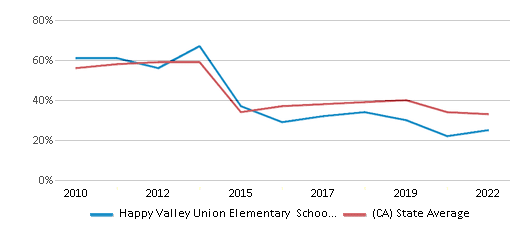
Reading/Language Arts Test Scores (% Proficient)
32%
47%
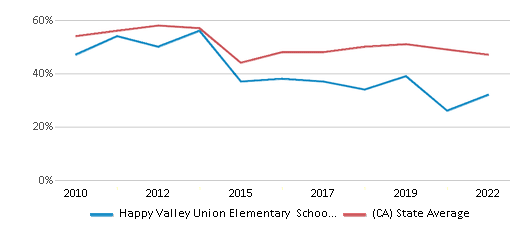
Science Test Scores (% Proficient)
25-29%
29%
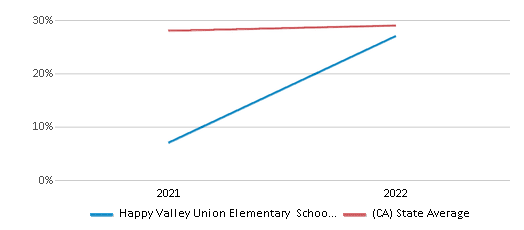
Students by Ethnicity:
Diversity Score
0.66
0.63
# American Indian Students
31 Students
25,796 Students
% American Indian Students
6%
1%
# Asian Students
40 Students
705,807 Students
% Asian Students
8%
12%
# Hispanic Students
93 Students
3,264,561 Students
% Hispanic Students
19%
56%
# Black Students
8 Students
286,112 Students
% Black Students
2%
5%
# White Students
260 Students
1,178,558 Students
% White Students
54%
20%
# Hawaiian Students
1 Student
23,731 Students
% Hawaiian Students
n/a
n/a
# Two or more races Students
51 Students
333,755 Students
% of Two or more races Students
11%
6%
Students by Grade:
# Students in PK Grade:
-
83
# Students in K Grade:
72
522,456
# Students in 1st Grade:
55
396,605
# Students in 2nd Grade:
53
414,466
# Students in 3rd Grade:
56
416,628
# Students in 4th Grade:
45
426,361
# Students in 5th Grade:
49
430,587
# Students in 6th Grade:
44
432,997
# Students in 7th Grade:
55
439,621
# Students in 8th Grade:
55
441,777
# Students in 9th Grade:
-
466,534
# Students in 10th Grade:
-
476,585
# Students in 11th Grade:
-
469,511
# Students in 12th Grade:
-
492,627
# Ungraded Students:
-
-
District Revenue and Spending
The revenue/student of $15,529 in this school district is less than the state median of $19,974. The school district revenue/student has declined by 19% over four school years.
The school district's spending/student of $14,502 is less than the state median of $18,396. The school district spending/student has declined by 19% over four school years.
Total Revenue
$8 MM
$116,387 MM
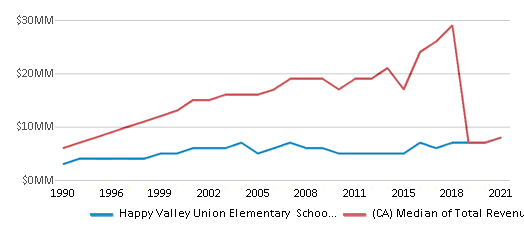
Spending
$7 MM
$107,188 MM
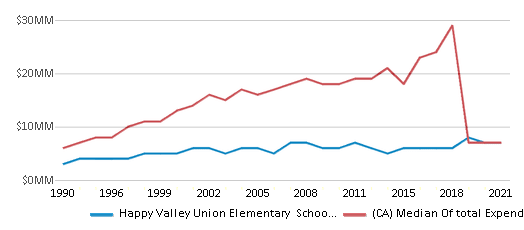
Revenue / Student
$15,529
$19,974
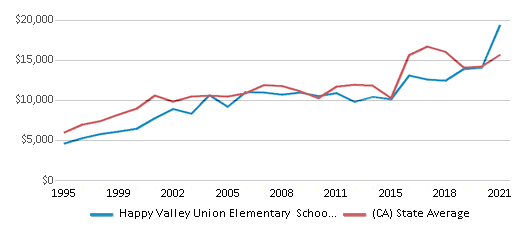
Spending / Student
$14,502
$18,396

Best Happy Valley Union Elementary School District Public Schools (2025)
School
(Math and Reading Proficiency)
(Math and Reading Proficiency)
Location
Grades
Students
Rank: #11.
Happy Valley Primary
(Math: 50-59% | Reading: 60-69%)
Rank:
Rank:
9/
Top 20%10
16300 Cloverdale Rd.
Anderson, CA 96007
(530) 357-2131
Anderson, CA 96007
(530) 357-2131
Grades: K-3
| 235 students
Rank: #22.
Happy Valley Community Day
Alternative School
(Math: <50% | Reading: <50%)
Rank:
Rank:
8/
Top 30%10
16300 Cloverdale Rd.
Anderson, CA 96007
(530) 357-2131
Anderson, CA 96007
(530) 357-2131
Grades: K-8
| 7 students
Rank: #33.
Happy Valley Elementary School
(Math: 21% | Reading: 27%)
Rank:
Rank:
3/
Bottom 50%10
17480 Palm Ave.
Anderson, CA 96007
(530) 357-2111
Anderson, CA 96007
(530) 357-2111
Grades: 4-8
| 242 students
Frequently Asked Questions
How many schools belong to Happy Valley Union Elementary School District?
Happy Valley Union Elementary School District manages 3 public schools serving 484 students.
What is the rank of Happy Valley Union Elementary School District?
Happy Valley Union Elementary School District is ranked #1137 out of 1,925 school districts in California (bottom 50%) based off of combined math and reading proficiency testing data for the 2021-2022 school year. This district ranks in the top 20% of California school districts for: Most diverse schools (Top 1%)
What is the racial composition of students in Happy Valley Union Elementary School District?
54% of Happy Valley Union Elementary School District students are White, 19% of students are Hispanic, 11% of students are Two or more races, 8% of students are Asian, 6% of students are American Indian, and 2% of students are Black.
What is the student/teacher ratio of Happy Valley Union Elementary School District?
Happy Valley Union Elementary School District has a student/teacher ratio of 20:1, which is lower than the California state average of 22:1.
What is Happy Valley Union Elementary School District's spending/student ratio?
The school district's spending/student of $14,502 is less than the state median of $18,396. The school district spending/student has declined by 19% over four school years.
Recent Articles

What Is A Charter School?
Explore the world of charter schools in this comprehensive guide. Learn about their history, how they operate, and the pros and cons of this educational innovation. Discover key facts about charter schools, including admission policies, demographics, and funding, as well as what to look for when considering a charter school for your child.

10 Reasons Why High School Sports Benefit Students
Discover the 10 compelling reasons why high school sports are beneficial for students. This comprehensive article explores how athletics enhance academic performance, foster personal growth, and develop crucial life skills. From improved fitness and time management to leadership development and community representation, learn why participating in high school sports can be a game-changer for students' overall success and well-being.

February 05, 2025
Understanding the U.S. Department of Education: Structure, Impact, and EvolutionWe explore how the Department of Education shapes American education, from its cabinet-level leadership to its impact on millions of students, written for general audiences seeking clarity on this vital institution.





